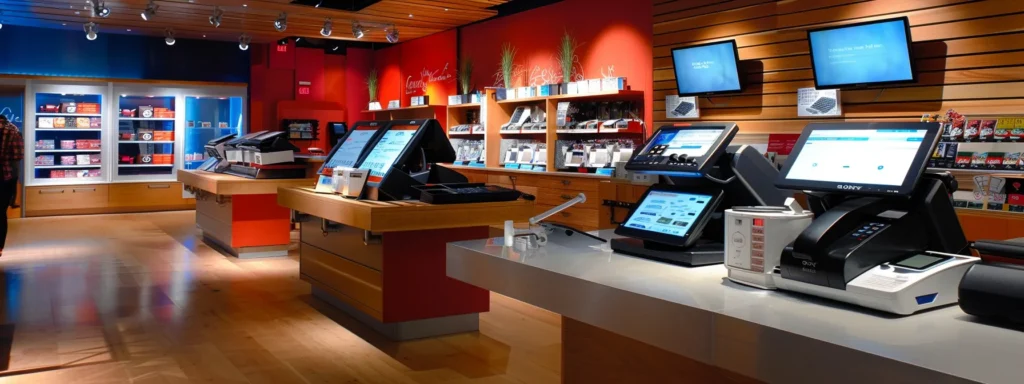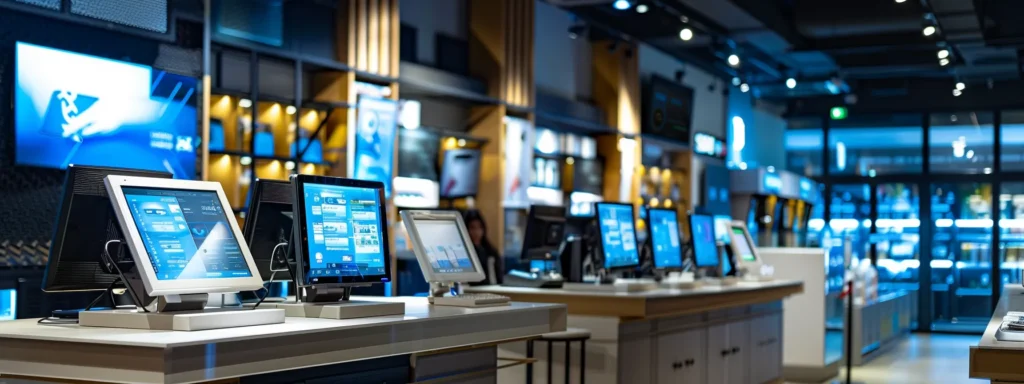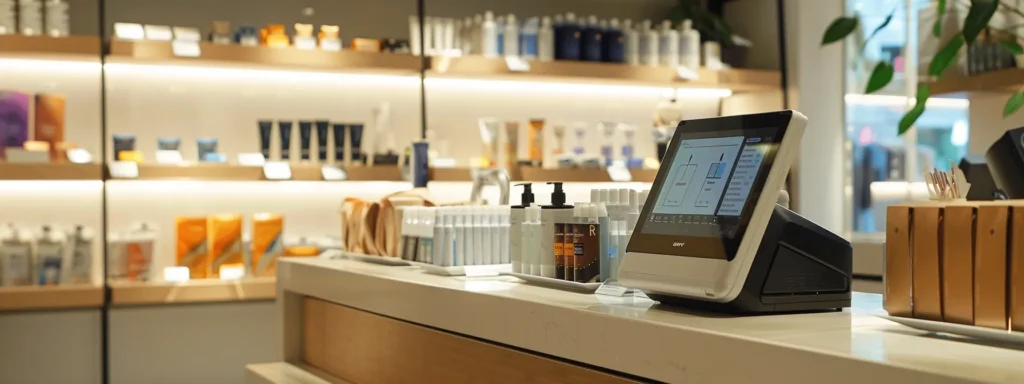
Table Of Contents:
- How to Choose the Right POS System for Your Store
- Key Takeaways
- Understanding the Functionality of POS Systems
- Assessing Your Store’s Requirements for a POS System
- Key Features to Look for in a POS System
- Evaluating Costs Associated With POS Systems
- Ensuring Scalability for Future Growth
- Making an Informed Decision on Your POS System
- Conclusion
How to Choose the Right POS System for Your Store
Choosing the right POS system can make or break your store’s efficiency and customer experience. This guide will help you navigate the selection process by focusing on functionality assessment, key features, and cost considerations. You’ll learn how to evaluate your store’s specific needs and find a scalable POS solution that grows with your business. By the end, you’ll be equipped to make an informed decision that streamlines operations and boosts your bottom line.
Key Takeaways
- Understand core POS features and identify unique needs before comparing software options
- Evaluate hardware compatibility and integration requirements with existing systems
- Consider scalability, customization options, and security features for future business growth
- Analyze upfront and recurring costs to find a cost-effective POS solution
- Seek recommendations, read reviews, and try demonstrations before making a final decision
Understanding the Functionality of POS Systems

To choose the right POS system for your store, you need to understand its core features, identify your unique needs, and compare software options. Whether you run a food truck or a brick-and-mortar shop, your POS should enhance customer experience, process card payments efficiently, and work with your internet setup. Consider factors like insurance compatibility and integration with your existing systems.
Define the Core Features of a POS System
Core features of a POS system include a user-friendly interface for both iOS and Android devices, seamless payment processing capabilities, and robust inventory management. Your chosen system should offer gift card functionality, integrate with various payment processors, and provide server management tools for restaurants. Look for a POS that emphasizes usability, allowing you to quickly train staff and efficiently serve customers.
Identify the Unique Needs of Your Store
Identify your store’s unique needs by evaluating your business type, size, and growth plans. Consider your bookkeeping requirements, bank account integration, and specific point of sale features essential for your operations. Assess your technology infrastructure and choose a POS solution that aligns with your current setup and future expansion goals. Your chosen system should streamline operations, enhance customer service, and provide valuable insights for decision-making:
| Business Type | Key POS Features |
|---|---|
| Retail | Inventory management, barcode scanning |
| Restaurant | Table management, menu customization |
| Service-based | Appointment scheduling, customer profiles |
Compare Different POS Software Options
When comparing POS software options, evaluate each system’s features, cost, and compatibility with your merchant needs. Consider the payment terminal options, kitchen integration capabilities for restaurants, and computer requirements for your setup. Assess the pos system cost against your budget, ensuring you get the best value for your investment. Look for solutions that offer scalability, robust reporting, and excellent customer support to meet your long-term business objectives.
Assessing Your Store’s Requirements for a POS System

Assess your store’s POS requirements by analyzing current business processes, determining necessary integrations, and evaluating hardware compatibility. Consider factors like cost, salesforce management, loyalty programs, merchant services, and customer retention. These steps will help you select a POS system that aligns with your business needs and enhances overall efficiency.
Analyze Your Current Business Processes
Analyze your current business processes to identify areas where a POS system can enhance customer engagement and streamline operations. Evaluate your existing payment methods, gift card programs, and customer database management. Consider how a POS tool can integrate these elements, improving efficiency and providing valuable insights for decision-making.
Determine Necessary Integrations With Existing Systems
Determine which integrations your existing systems require when selecting a POS system. A good POS system like Clover POS should seamlessly connect with your email marketing tools, inventory management software, and accounting platforms. Consider how the POS will work with your current countertop hardware and whether it offers the necessary features for your business type. Ensure the chosen system can handle your specific needs, such as gift card programs or loyalty rewards, to create a cohesive operational environment.
Evaluate Hardware Compatibility and Needs
Evaluate your hardware compatibility and needs to ensure your chosen POS system aligns with your existing equipment and future requirements. Consider the processing fees associated with different hardware options and how they impact your overall investment. Look for systems that offer automation features to streamline transaction processing and improve accessibility for both staff and customers. Assess whether the hardware can handle your expected transaction volume and if it integrates seamlessly with your current setup, maximizing efficiency and return on investment.
Key Features to Look for in a POS System

When selecting a POS system, focus on key features that enhance your store’s operations. Look for a user-friendly interface, robust inventory management, and customer relationship management tools. Prioritize security and compliance standards to protect your cash flow and prevent fraud. A good POS provider will offer these features, streamlining your workflow and supporting loyalty programs for better customer retention.
Focus on User-Friendly Interface
Choose a POS system with a user-friendly interface to streamline your retail operations. Look for intuitive pos hardware that allows easy navigation and quick transaction processing on mobile devices. Ensure the system offers encryption to protect sensitive data and provides clear feedback on transaction status. A well-designed interface reduces training time and improves efficiency, allowing you to serve customers faster and more effectively.
Explore Inventory Management Capabilities
When exploring inventory management capabilities, look for a POS system that automates stock tracking and provides real-time updates. Your chosen system should generate accurate receipts, handle tax calculations, and support EMV transactions for secure shopping experiences. Ensure the POS offers contract management features to streamline vendor relationships and maintain consistent stock levels.
Importance of Customer Relationship Management Features
Customer relationship management features in your POS system are crucial for enhancing customer loyalty and driving sales. Look for a system that integrates with your inventory management software, allowing you to track customer preferences and purchase history. This integration enables you to personalize your menu offerings and apply accurate sales tax percentages. Choose a POS with a robust payment processor that supports loyalty programs, helping you retain customers and increase their lifetime value.
Consider Security and Compliance Standards
When selecting a retail POS system, prioritize security and compliance standards to protect your business and customer data. Choose a POS solution that offers robust encryption for credit card transactions and complies with PCI DSS requirements. Ensure your business software includes features like user access controls and regular security updates to safeguard sensitive information. Consider POS systems that provide data backups and disaster recovery options to protect your retail operations from potential disruptions:
| Security Feature | Benefit |
|---|---|
| Encryption | Protects sensitive data during transactions |
| PCI DSS Compliance | Ensures adherence to industry security standards |
| User Access Controls | Limits data access to authorized personnel |
| Regular Updates | Addresses new security threats promptly |
Evaluating Costs Associated With POS Systems

Evaluate POS system costs by understanding upfront and recurring expenses, comparing pricing models, and assessing the value of additional features. Consider how these factors affect your table of contents, scalability, customer management, payroll, and inventory control. Analyze each aspect to ensure you choose a cost-effective solution that meets your store’s needs and budget constraints.
Understand Upfront and Recurring Costs
When evaluating costs for your POS system, consider both upfront and recurring expenses to maximize profit. Upfront costs may include hardware for your brick and mortar store, such as mobile POS devices and card readers. Recurring fees often cover software licenses, payment card industry compliance, and transaction processing. Be sure to factor in potential hidden costs like setup fees or charges for additional features to get a complete picture of your investment in a mobile POS system.
Compare Pricing Models Among Different Providers
Compare pricing models among different POS providers to find the most cost-effective solution for your store. Look for providers offering flat rate pricing structures, which can simplify your expense tracking and budgeting process. Consider systems that support Apple Pay and other popular payment methods to enhance customer convenience. Evaluate providers that include barcode scanning capabilities in their base package, as this can save you money on additional hardware. Use a spreadsheet to compare features and costs across providers, ensuring you get the best value for your investment.
Assess the Value of Additional Features
Assess the value of additional POS features by evaluating their impact on your small business operations. Consider how enhanced interface options and vendor management tools can streamline your workflow both online and offline. Weigh the benefits of these pos features against their cost, ensuring they align with your business needs and budget constraints. Remember that some features may qualify for small business loans if they significantly improve your operational efficiency.
Ensuring Scalability for Future Growth

When selecting a POS system, consider its scalability to support your store’s future growth. Evaluate the system’s flexibility for business expansion, ensuring it can handle increased cash flow and cashier demands. Look for POS software with customization options that adapt to your evolving needs, offering a comprehensive dashboard for money management and sales tracking. This approach ensures your POS solution remains effective as your business grows.
Evaluate the System’s Flexibility for Business Expansion
Evaluate your POS system‘s flexibility for business expansion by assessing its ability to accommodate growth in sales volume, product lines, and customer data. Choose an option that offers scalable features to protect your return on investment as your brand evolves. Ensure the system provides robust data security measures to safeguard increasing consumer information and transactions, allowing you to expand confidently without compromising protection.
Look for Customization Options to Fit Evolving Needs
Look for POS systems that offer customization options to adapt to your evolving business needs. Choose a system with flexible features that can support omnichannel strategies, enhancing customer experience across various touchpoints. Ensure the POS provider offers robust customer support to assist with customizations and provide guidance on leveraging new features as your entrepreneurship journey progresses. Consider systems that allow you to tailor customer service processes, enabling you to maintain high-quality interactions as your business grows. The right customizable POS solution will help you scale your operations while maintaining excellent customer service:
| Customization Area | Benefit for Growth |
|---|---|
| Omnichannel Integration | Seamless customer experience across platforms |
| Customer Service Workflows | Tailored processes for efficient issue resolution |
| Reporting and Analytics | Customized insights for data-driven decisions |
| User Interface | Adaptable layout for evolving business needs |
Making an Informed Decision on Your POS System

To make an informed decision on your POS system, seek recommendations from other retailers and read reviews. Consider trial options and demonstrations to test features like contactless payment and invoicing. Analyze customer support quality to ensure you can enable key functions efficiently. This approach will help you find a top POS system that handles debit card transactions and meets your store’s needs.
Seek Recommendations and Reviews From Other Retailers
Seek recommendations and reviews from other retailers to gain valuable insights into various POS systems. Look for testimonials about the onboarding process, tokenization features, and overall payment system reliability. Pay attention to feedback on hardware components like printers and cash registers, as these can impact your daily operations. By consulting peers, you’ll better understand how different POS solutions perform in real-world retail environments, helping you make a more informed decision for your store.
Consider Trial Options and Demonstrations
Consider trial options and demonstrations from various POS providers to test their systems firsthand. Use these opportunities to evaluate pos terminals, assess merchant account integration, and gauge communication efficiency. Try out key features like inventory management and reporting to ensure they meet your store’s needs. This hands-on experience will help you make a more informed decision when selecting your POS system.
Analyze Customer Support and Service Quality
Analyze the customer support and service quality of potential POS system providers to ensure reliable assistance for your small business. Evaluate their response times, availability of mobile app support for Android devices, and expertise in commerce-related issues. Look for providers offering comprehensive small business resources, including tutorials and troubleshooting guides, to help you maximize your POS system‘s potential. By choosing a provider with excellent support, you’ll have the backing you need to navigate any challenges and keep your business running smoothly.
Conclusion
Selecting the right POS system is crucial for your store’s efficiency, customer satisfaction, and future growth. A well-chosen system streamlines operations, enhances inventory management, and improves customer relationships through integrated features and data insights. By carefully evaluating your store’s unique needs, comparing different options, and considering factors like cost, scalability, and security, you can make an informed decision that aligns with your business goals. Ultimately, investing time in choosing the right POS system pays off by providing a solid foundation for your store’s success and adaptability in the ever-changing retail landscape.